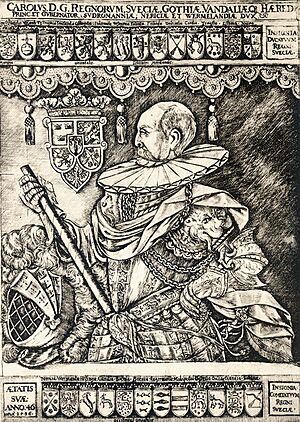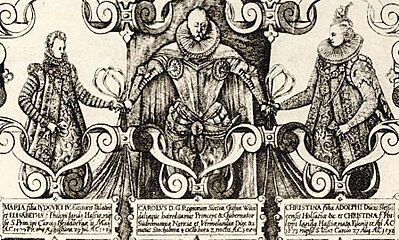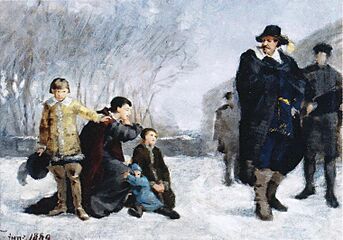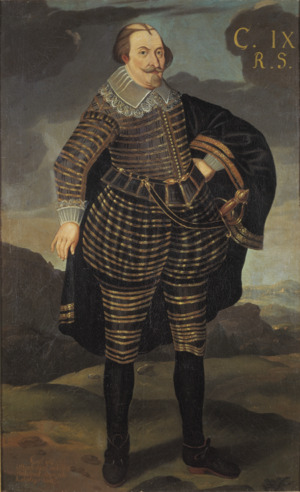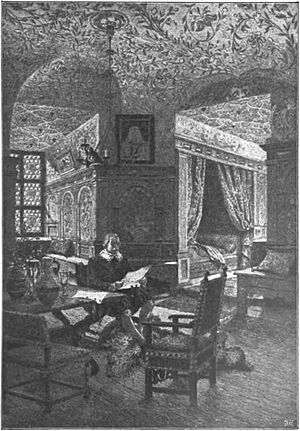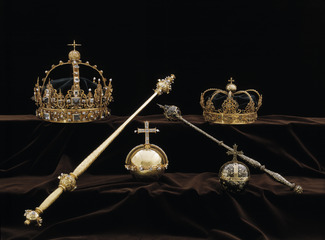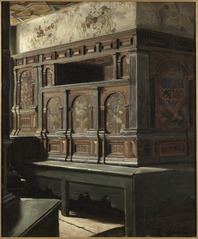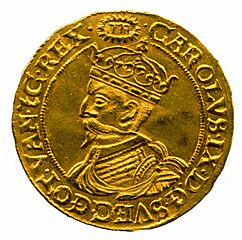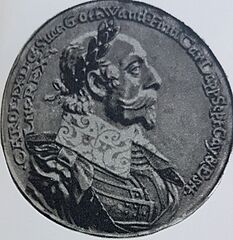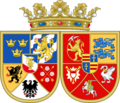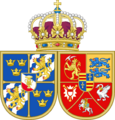Charles IX of Sweden facts for kids
Quick facts for kids Charles IX |
|
|---|---|
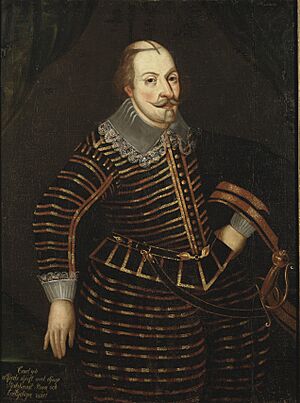
Charles IX by an unknown artist, Nationalmuseum
|
|
| King of Sweden | |
| Reign | 22 March 1604 – 30 October 1611 |
| Coronation | 15 March 1607 |
| Predecessor | Sigismund |
| Successor | Gustav II Adolf |
| Born | 4 October 1550 Stockholm Castle, Stockholm, Sweden |
| Died | 30 October 1611 (aged 61) Nyköping Castle, Nyköping, Sweden |
| Burial | 21 April 1612 Strängnäs Cathedral |
| Spouse |
Maria of Palatinate-Simmern
(m. 1579; died 1589)Christina of Holstein-Gottorp
(m. 1592) |
| Issue Detail |
Princess Margareta Princess Elisabeth Prince Louis Catherine, Countess Palatine of Kleeburg Prince Gustav Princess Maria Princess Christina Gustav II Adolf of Sweden Princess Maria Elizabeth, Duchess of Östergötland Prince Charles Philip, Duke of Södermanland Carl Gyllenhielm (ill.) |
| House | Vasa |
| Father | Gustav I of Sweden |
| Mother | Margaret Leijonhufvud |
| Religion | Lutheran |
| Signature | |
Charles IX (born 4 October 1550, died 30 October 1611) was the King of Sweden from 1604 until his death. He was the youngest son of King Gustav I and his second wife, Margaret Leijonhufvud. Charles was also the brother of King Eric XIV and King John III of Sweden, and the uncle of Sigismund III Vasa. Sigismund later became king of both Sweden and Poland.
Charles became king during a time of big religious disagreements in Europe. These arguments were between different groups of Christians, mainly Protestants and Catholics. Charles strongly supported the Protestant side. His nephew, Sigismund, was a devoted Catholic. This difference in religion caused a lot of tension and led to Charles becoming king of Sweden instead of Sigismund.
Charles's reign was an important part of the Protestant Reformation, a period when many people broke away from the Catholic Church. It also marked the end of the Counter-Reformation, which was the Catholic Church's response to the Reformation.
Contents
Duke Charles: A Champion of Protestantism
When Charles was young, his father, King Gustav I, gave him the Duchy of Södermanland to rule. This area included the provinces of Närke and Värmland. He officially took control of these lands in 1569.
In 1568, Charles played a key role in a rebellion against his brother, King Eric XIV. However, his relationship with his other brother, King John III, was often difficult. Charles was a strong supporter of Lutheranism, a form of Protestantism. He disagreed with John III's attempts to bring Sweden closer to Catholic traditions.
When John III died in 1592, his eldest son, Sigismund III Vasa, was supposed to become king. But Sigismund was already the King of Poland and a very strict Catholic. Many Protestants in Sweden, especially the common people and lower nobles, worried that Sigismund would try to make Sweden Catholic again. Charles stepped forward to protect the Protestant faith and the House of Vasa family from outside influence.
Uppsala Synod and Regency
Thanks to Charles, Sigismund was forced to agree to the decisions made at the Uppsala Synod in 1593. This meeting officially declared that Sweden was a Lutheran Protestant country. Under this agreement, Charles and the Swedish Privy Council (a group of advisors) shared power and ruled Sweden in Sigismund's name, as Sigismund lived in Poland.
Charles faced many challenges during this time (1593–1595). He had to resist Sigismund's attempts to change things back to how they were. He also had to control the nobility, who wanted more power for themselves. Charles worked closely with the clergy (church leaders) and the common people. Because of this, the Riksdag of the Estates (Sweden's parliament) gained more power than ever before.
In 1595, the Riksdag elected Charles as regent, meaning he would rule until a king was properly in place. Charles tried to make Klaus Fleming, the governor of Finland, obey his authority instead of the king's. This led to a civil war. Sigismund eventually invaded Sweden with an army to settle the conflict.
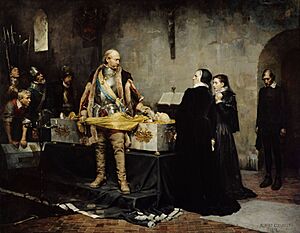
In 1597, after some fighting, Fleming died. Charles then went to Turku Castle in Finland. A story says that Charles had Fleming's coffin opened to make sure he was dead. He supposedly pulled Fleming's beard and said, "If you had been alive, your head would not have been safe!" Fleming's wife, Ebba Stenbock, bravely replied, "If my late husband was alive, Your Grace would never have been here."
Charles was technically acting against the king, which was a serious crime. But in 1598, Sigismund lost an important battle called the Battle of Stångebro. Sigismund was captured and forced to hand over some Swedish noblemen who Charles considered traitors. These noblemen were later executed in what was known as the Linköping Bloodbath. With Sigismund defeated and exiled, the Riksdag officially removed him from the throne in 1599. They then named Charles as the ruler and regent.
-
Kristina Banér Pleads for Her Husband (Painting by Helene Schjerfbeck, 1882)
King Charles IX
On 24 February 1604, the Riksdag at Linköping declared that Sigismund had given up the Swedish throne. Duke Charles was then recognized as the new ruler and became King Charles IX.
Charles's short time as king was filled with wars. He fought against Poland for control of lands like Livonia and Ingria. This led to the Polish–Swedish War (1600–1611) and the Ingrian War. He also claimed lands in Lappland, which caused a war with Denmark-Norway in his last year, known as the Kalmar War.
Charles was not very successful in these wars. This was partly because he faced very skilled generals like Jan Karol Chodkiewicz and Christian IV of Denmark. He officially became king on 22 March 1604, but his coronation ceremony didn't happen until 15 March 1607.
-
The reverse side depicting his sons Gustav Adolf and Charles Philip
Death and Legacy
Charles IX died at Nyköping on 30 October 1611. His seventeen-year-old son, Gustavus Adolphus, who had already been involved in the wars, became the next king.
Charles IX is seen as an important link between his father, Gustav I, and his famous son, Gustavus Adolphus. He helped make Sweden a strong Protestant country, continuing the work of his father. He also set the stage for his son to build a powerful Protestant empire.
Children
Charles IX married twice.
His first wife was Anna Marie of Palatinate-Simmern (1561–1589). Their children were:
- Margareta Elisabeth (1580–1585)
- Elisabeth Sabina (1582–1585)
- Louis (1583–1583)
- Catherine (1584–1638), who became the mother of Charles X Gustav.
- Gustav (1587–1587)
- Maria (1588–1589)
In 1592, he married his second wife, Christina of Holstein-Gottorp (1573–1625). Their children were:
- Christina (1593–1594)
- Gustavus Adolphus of Sweden (Gustav II Adolf) (1594–1632)
- Maria Elizabeth (1596–1618)
- Charles Philip (1601–1622)
Charles also had a son with his mistress, Karin Nilsdotter:
- Carl Carlsson Gyllenhielm (1574–1650), who became a Field Marshal.
Arms
-
Arms of Charles as Prince of Sweden, and Duke of Södermanland
Images for kids
-
Funeral monument of Carl IX and family at Strängnäs Cathedral
-
Reveal of a grand statue of him in Göteborg, 1904
-
Statue of Charles IX in Karlstad, 1926
-
Relief on a wall of the Stockholm Palace
See also
 In Spanish: Carlos IX de Suecia para niños
In Spanish: Carlos IX de Suecia para niños
- History of Sweden — Rise of Sweden as a Great Power
- Battle of Kircholm
- Battle of Stångebro
- Kings of Kvenland — Charles claimed to be King of the Caijaners from 1607 to 1611


